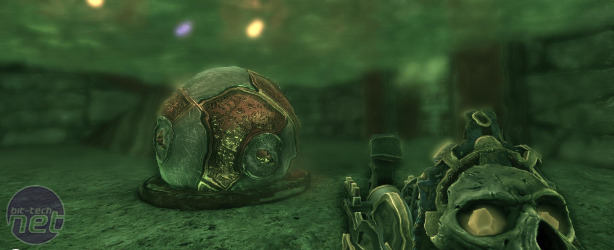
Balls of Steel
The biggest problem that The Ball has though isn’t with the puzzles, but what comes between them. There are two things that Teotcl has added in to try and break the pace up a little. The first is combat, the second is…nothing. We should probably explain.Progress in The Ball is actually pretty dull a lot of the time and, while the levels certainly look nice and showcase some rather attractive architecture, we’d find it hard to say that The Ball was a game with much in the way of charisma. Time spent not solving puzzles or dealing with enemies is spent simply walking from A to B, with nothing else to occupy your attention. There’s no characters to talk to, no voice to guide you and no GlaDOS to taunt you.
That unfortunately leaves The Ball as a very beautiful and eventually very clever game which loses out on a chance to become truly memorable because it has no narrative whatsoever. There’s not even any attempt to conjure a closeness between the player and the ball they are repeatedly staking their life on. The Ball is, sadly, not a Companion Cube analogue…it’s just a big, metal ball. When it rolled out of sight we honestly couldn’t have cared less.
Teotcl has instead elected to plug this gap with combat sections which usually see the player getting rushed by a small horde of the undead beasties who call the cave their home. You have to rolls the ball around to crush them as fast as possible and, while it’s fun to watch the blood spatter around the first few times it happens, there’s not enough depth to warrant repeated attention.
Boss fights and the added Survival Mode serve as an exception to this, scaling up the violence and size of the combat to create something a bit more exciting, but it’s all much of a muchness. The Ball is clearly a puzzle game at heart and that's never more clear than when you’re chasing after your ball as it rolls past the enemies, taking damage and hammering the right mouse button to summon it back.
As a result of this, the combat arenas that regularly feature into The Ball’s single player campaign are left feeling like fairly blatant padding rather than alegitimately interesting way to change the pace. What The Ball really needs isn’t large scale battles, but more interesting puzzles layered in more quickly and
 something to break up the flow a bit. We got so lonely that we started talking to our ball at one point, so why shouldn’t it talk back?
something to break up the flow a bit. We got so lonely that we started talking to our ball at one point, so why shouldn’t it talk back?Despite the faults though, The Ball remains an entertaining game on the whole and, while it takes a while to get going, it’s ultimately worth it when it gets there. Even the simplest puzzles are fun to solve in their way and occasionally manage to throw an unexpected curveball into the mix.
It’s a shame that The Ball appears to settle for being an average game, rather than the truly stellar, must-play title it could have so easily and obviously have been. As it is, it’s worth a look if you’re looking for a slow-burning brainteaser, but not worth any particular recommendation on any other front.
Score Guide

MSI MPG Velox 100R Chassis Review
October 14 2021 | 15:04











Want to comment? Please log in.